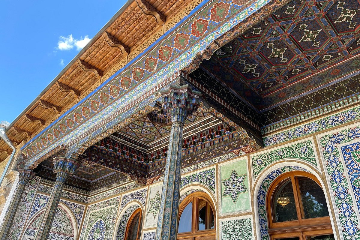Step through the carved wooden gates of the State Museum of Applied Art and find yourself inside a living kaleidoscope of Uzbekistan’s soul. This isn’t just a museum—it’s a time-warped mansion where every archway hums with stories of silk-road caravans, tsarist diplomats, and artisans whose hands shaped beauty from clay, thread, and metal. Housed in the 19th-century Polovtsev House, a former Russian diplomat’s residence transformed into an oriental fantasy by master craftsmen , the building itself is your first exhibit. Run your fingers along walls alive with ganch carvings of pomegranate vines, their curves echoing the rhythm of Uzbek folk songs, and gaze up at ceilings painted with celestial patterns that mirror Samarkand’s starry skies.

Your journey begins in 1927, when this opulent hybrid of European structure and Uzbek ornament hosted its first exhibition of local crafts—a revolutionary act in an era of political upheaval . Today, over 7,000 artifacts whisper tales across two centuries. In the "Ancient Roots" gallery, 19th-century suzani embroideries explode with scarlet poppies—each stitch a mother’s prayer stitched into her daughter’s dowry. Nearby, Chust knives glint like crescent moons, their curved blades forged by Namangan blacksmiths who still chant blessings into molten steel. Notice how the handles tilt downward—a design quirk meant to honor both utility and poetry, as if the knife itself bows to its user .
But the true showstopper awaits in the Ceramic Hall. Here, Rishtan’s azure masterpieces glow under soft light, their cobalt swirls mimicking Fergana Valley rivers. Lean closer: the secret ishkor glaze, made from desert weeds, gives these vessels an otherworldly sheen. Touch the replica workshop display (cold clay, rough under fingertips) and imagine 12th-century potters singing Sufi verses as their wheels spun . Contrast this with the "Threads of Revival" section, where Madina Kasimbaeva’s 8-meter suzani embroidery drapes like a textile galaxy—a modern masterpiece reviving Tashkent’s near-lost stitching techniques, its sun-and-planet motifs stitched by 15 artisans over three painstaking years .
Don’t rush past the "Living Crafts" corridor. On Thursday mornings, the air buzzes with the tap-tap of coppersmiths demonstrating ancient kundal engraving. Watch as a wizened master transforms a brass plate into a labyrinth of floral geometry, his chisel dancing to a rhythm perfected over decades. Nearby, a teenage girl stitches a skullcap with neon threads—proof that tradition isn’t frozen, but living .
As you exit, glance back at the Polovtsev House’s facade—its Soviet-era additions now harmonizing with 19th-century majolica tiles. This architectural dialogue mirrors Uzbekistan itself: a nation weaving past and present into something dazzlingly alive. The museum doesn’t just display art; it lets you walk through the loom where history, hands, and heart collide.




































